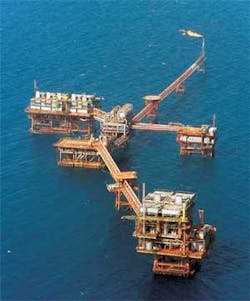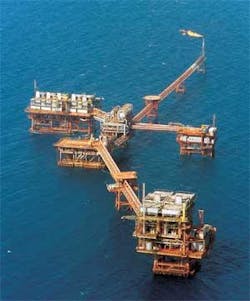At its most fundamental, deepwater exploration and development is about cost and risk. In the past two decades, advancing technology has made it possible to dramatically reduce both. The result is increased exploration success and a lower commercial threshold that makes more discoveriesin ever deeper watercommercially viable.
Petroleum demand will continue to grow and deep water fields will be increasingly important in meeting that demand.
In late 2007, Douglas-Westwood updated its World Deepwater Market Report to cover 2008-2012. The report, for water depths of 500 m (1,640 ft) and more, forecasts annual worldwide capital spending will reach nearly $25 billion over the period. “The deepwater oil and gas industry is set for continued growth through to 2012, with over 30% growth forecast for 2008-2012, compared with the previous five years,” said John Westwood, Managing Director, at PennWell’s Deep Offshore Technology International Conference and Exhibition in Stavanger.
Deepwater oil production currently accounts for almost 15% of total offshore production, but deep water will represent about 20% of offshore production by 2011, he said. Together, Africa, the Gulf of Mexico and Brazil will account for 84% of global deepwater spending over the period, said Westwood.
Advancing technology continues to bring new discoveries in Egypt’s existing concessions. And it enhances interest in prospects in even deeper water, as evidenced by the results of a recent bidding round.
But executing Egypt’s deepwater projects pose a wide variety of technical challenges, including a difficult geo-technical environment, a variety of reservoir pressures and fluid compositions, and high temperature/high pressure conditions. Besides meeting these immediate challenges in each development project, the high cost of deepwater operations makes it important to provide for future growth and expansion.
Geologic setting
In Egypt’s prospective deepwater areas, the spectrum of technology available today to understand and optimize the life cycle value of a discovery is especially important because of the complexity of many of the productive zones. The main producing reservoirs in the western part of the Nile Delta deep water are mostly submarine channel features, with extended submarine fans farther north. Sealing rocks are provided by the intra-formational Pliocene-Pleistocene mud stone.
Gas comes from both thermogenic and biogenic sources and includes some condensate. Only shallow reservoirs in one or two fields contain gas entirely from a biogenic origin; the majority of discoveries suggests a predominantly thermogenic origin.
Migration of hydrocarbons from Oligocene- Miocene source rocks probably occurred along the active faults. Currently, evidence of the pre- Tertiary sources is proven by carbon isotopes.
The major structural elements are the southwest/northeast trending Rosetta fault and the east-northeast/west-southwest trending Nile Delta offshore anticline (NDOA) high. Both of these were active at various periods during the Pliocene-Pleistocene periods. But they have not had a major impact on the depositional geometries of the Upper Pliocene channels, which when traced in map and seismic sections, show no significant thickening or change in style across the features.
The crestal part of the east-northeast trending NDOA is collapsed by a tectonic listric fan developed in response to a cycle of negative tectonic inversion where the extensional regime dominated in the Upper Early Pliocene. This indicates that the time of the tectonic inversion along the east-northeast trend is younger than that on the northeast-trending Rosetta belt.
Applying technology
Using up-to-date techniques enhances reservoir understanding, leading to a more accurate estimate of reserves, and better well and reservoir optimization. Rashpetco uses the latest technology to maximize hydrocarbon productivity and reduce development risk in the offshore deltaic area.
Seismic inversion is used to calculate the relative and absolute acoustic impedance to discriminate between the hydrocarbon bearing sands and non-reservoir zones. However, this technology may fail to discriminate between shale and water-bearing sand, according to the company, and pre-stack amplitude variation with offset (AVO) inversion was used successfully as a lithology and fluid indicator.
The technique reduces drilling risk and improves static and dynamic reservoir models. The rock physics model is also essential in offshore deltaic sequences, according to Rashpetco.
In addition to defining lithology and fluid content, parallel multiple 3D seismic attributes are used to define the stratigraphic and structural setting of the area. Long offset seismic re-processing trials reduce risk by enhancing the horizontal and vertical resolutions of reservoir sequences.
Thin bedded intervals containing significant amounts of net pay identified in the Mediterranean are considered by Rashpetco as potential development targets. These thin bed successions are often less than 10 cm thick, sandstone and siltstone sheets deposited from sediment gravity flows and inter-bedded with shale.
Lateral continuity, connectivity and bed lengths are important influences on reservoir performance and recovery that cannot be deduced from seismic and conventional well log data. Rashpetco used combinations of tools in different fields to image these unconventional pays and quantify hydrocarbon pore volume.
Reservoir modeling was used to test the impact of these unconventional pays on gasin- place calculations.
Hardware upgrades are also necessary to be able to use the latest modeling and analysis software. Rashpetco’s 54 new Linux workstations are allocated for exploration staff. Soon, the four terabyte storage will be upgraded to six terabytes.
Still deeper water
Late last year, Statoil ASA was awarded two deepwater blocks in Egypt’s most recent bidding round in water depths between 1,000 and 3,000 m (3,280-9,840 ft).
Statoil is operator and an 80% working interest owner in Block 10, the second award of exploration acreage secured by the group late last year. Sonatrach International Petroleum Exploration & Production (Sipex), a whollyowned subsidiary of Algerian state oil and gas company Sonatrach, owns a 20% working interest. The block will be operated under a production sharing agreement.
Earlier, Statoil was awarded an 80% working interest in block 9 in the area and will be the operator of the block. Blocks 9 and 10 are west of the Nile Delta, and cover areas of 8,368 sq km (3,231 sq miles) and 9,802 sq km (3,785 sq miles) respectively.
Shell Egypt, too, has a long history of investment in oil and gas exploration in Egypt. In recent years, the company has increasingly targeted gas exploration, in line with Egypt’s drive to develop its gas resources. Shell Egypt won the Northeast Mediterranean Deepwater Concession in 1998, a large concession north of the Nile Delta in water depths between 800 and 2,800 m (2,625-9,185 ft). The company committed $150 million to a preliminary five-year exploration period, and two of these exploration wells were completed in 2000/2001.
Shell Egypt’s reservoir modeling expertise has been useful in the complex geology of the Western Desert, as well as in the North East Mediterranean deepwater concession.
Shell Egypt is a 40% equity owner in the Rosetta field, which came on stream in January 2001.
Operated by Rashpetco, Phases I and II of the concession development is complete. Rosetta Phase II includes four development wells on an unmanned offshore platform producing about 230 MMcfd for the domestic market. Rosetta Phase III was under way at mid 2007.
Change for Tomorrow: THE INJAZ PROJECT
BP Egypt has been always a strong supporter of the local Injaz project. Injaz Egypt was originally implemented by Save the Children Federation Inc. and is contributing to Egypt’s drive to promote a private sector based economy by teaching young public school children the basics of economics.
Injaz Egypt aims to help young people gain an understanding of: the importance of personal strategic planning; marketdriven economies; business in a global economy; business commitment in environmental and social issues; education in the workplace; and the impact of economics on their future.
BP Egypt employees have been very dedicated over the years and even volunteer teaching preparatory public school children (age group 13-15) an Injaz pre-designed curriculum called “Success Skills” by donating one hour per week for a period of 10 weeks.




